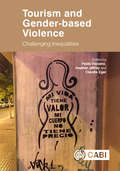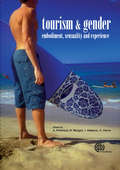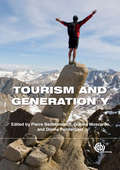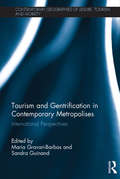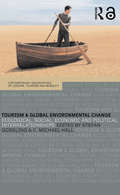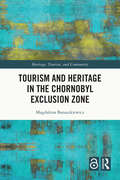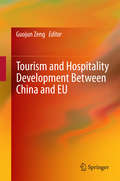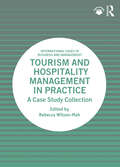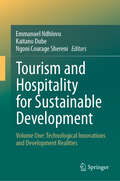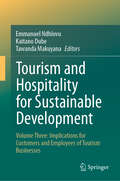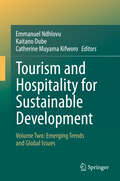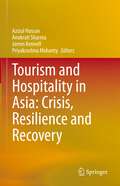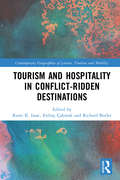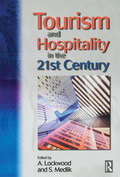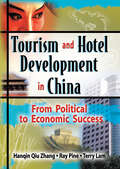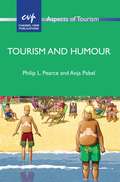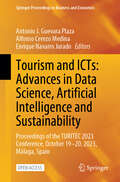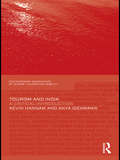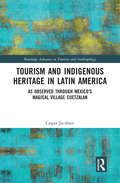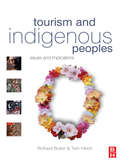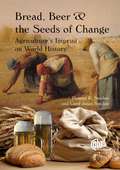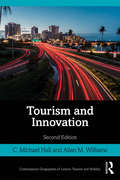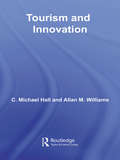- Table View
- List View
Tourism and Gender-based Violence: Challenging Inequalities
by Isis Arlene Díaz-Carrión Donna Chambers Elaine Chiao Yang Dimitrios Stylidis Lauren Duffy Laura Aguilera Ávila Sara Ali Abdelghani Zaid Alrawadieh Yaxin Chen Jannick Friis Christensen Derya Demirdelen Ayla Deniz Jocelyn Finniear Ching-Hua Ho Ismail Kervankiran Ellen Koppa Tenia Kyriazi Nigel J Morgan Ana María Munar Alberto Jonay Rodríguez Darias Hande TurkogluGender based violence (GBV) in travel and tourism is embedded within wider social structures of gender inequalities and discrimination. This book focuses on the multiple and interconnected manifestations of violence that women and girls encounter in tourism consumption and production, such as physical, sexual, emotional or socio-economic abuse. The book adopts a multidisciplinary perspective in its critical examination of the theoretical landscape of GBV, and its engagement with case studies on GBV and sexual harassment. It draws on feminist, intersectional and post-colonial frameworks, bringing together contributions from academics and practitioners across the globe. This book: Provides a critical approach to gender-based violence as part of broader social structures of inequality and discrimination in the tourism and hospitality industries. Draws on a range of disciplinary approaches, includinggender studies, geography, international relations, law, sociology and tourism studies. Brings together work by scholars who are engaging with the concept of gender-based violence in a wide range of tourism settings and practices. Includes profiles of organisations and initiatives that are attempting to tackle GBV in tourism, hospitality and beyond. Exploring an important topic of current times, this book will be of interest to researchers and practitioners in the areas of tourism, hospitality, gender studies, international relations, law, geography and sociology.
Tourism and Gender: Embodiment, Sensuality and Experience
by Annette Pritchard Nigel Morgan Irena Ateljevic Candice HarrisThis book seeks to advance feminist and gender tourism studies with its focus on embodiment. Broad themes include the construction of narratives, how discourses of desire, sensuality and sexuality pervade the tourism experience, the use of the body to represent femininity, masculinity and sensuality, and finally how travel and tourism allow for empowerment, resistance and carnivalesque opportunities.
Tourism and Generation Y
by Gianna Moscardo Pierre Benckendorff Donna PendergastThis book looks at Generation Y in a tourism context; in broad conceptual terms such as trends and behavior, and in applied terms, for example looking at particular types of travel that Generation Y takes part in, and tourism marketing aimed specifically at them. This volume aims to define and examine the current and future generation of tourism workers and consumers, and will be an essential read for researchers and students in tourism studies and related industries.
Tourism and Gentrification in Contemporary Metropolises: International Perspectives (Contemporary Geographies of Leisure, Tourism and Mobility)
by Maria Gravari-Barbas Sandra GuinandTourism gentrification is a critical shaping force of socio-economic and contemporary urban landscapes. This book aims to be the first substantive text on this subject, explaining the multiple and complex relationships between tourism and gentrification and their outcomes and manifestations in contemporary metropolises. This is achieved by drawing on in-depth case analyses addressing the different issues at stake. Part I deals with the manifestations of tourism gentrification and the ways it affects urban landscapes through heritagization and urban regeneration strategies. Part II looks at the correlations between tourism gentrification and culture. Finally, the last two parts aim to identify and examine forms and expressions of tourism gentrification, distinguishing among the actors, beneficiaries, and victims of the phenomenon while looking at its implications for intra-metropolitan territories and metropolitan governance. The book approaches these issues in an innovative way, by looking at a variety of metropolises in a diverse range of countries and by dealing with the different relations and management issues generated by gentrification in relation to tourism. Through interdisciplinary approaches, this groundbreaking text sheds light on the role tourism plays in contemporary metropolises, furthering knowledge of urban tourism. For these reasons, it will be of particular interest to scholars and students of tourism, urban studies, geography, anthropology and sociology.
Tourism and Geopolitics
by Derek HallWith 29 contributors from across Europe and beyond, this work represents a unique and important resource that examines the many relationships between tourism and geopolitics, with a focus on experiences drawn from Central and Eastern Europe. It begins by assessing the changing nature of 'geopolitics', from pejorative associations with Nazism to the more recent critical and feminist geopolitics of social science's 'cultural turn'. The book then addresses the important historical role of Central and Eastern Europe (CEE) in geopolitical thinking, before exemplifying a range of contemporary interactions between tourism and geopolitics within this critical region. Edited by a renowned authority on tourism geopolitics, this book: #65533; Provides the most comprehensive overview of tourism and geopolitics available #65533; Applies a range of geopolitical concepts and approaches to empirical experiences of tourism and mobility in Central and Eastern Europe #65533; Embraces contributions from both established and new academic voices. Pursuing innovative analytical paths, the book demonstrates the interrelated nature of tourism and geopolitics and emphasizes the freshness of this research area. Addressing key principles and ideas which are applicable globally, it is an essential source for researchers, teachers and students of tourism, geography, political science and European studies, as well as for diplomatic, business and consultant practitioners.
Tourism and Geopolitics: Issues and Concepts from Central and Eastern Europe
by Derek HallWith 29 contributors from across Europe and beyond, this work represents a unique and important resource that examines the many relationships between tourism and geopolitics, with a focus on experiences drawn from Central and Eastern Europe. It begins by assessing the changing nature of 'geopolitics', from pejorative associations with Nazism to the more recent critical and feminist geopolitics of social science's 'cultural turn'. The book then addresses the important historical role of Central and Eastern Europe (CEE) in geopolitical thinking, before exemplifying a range of contemporary interactions between tourism and geopolitics within this critical region. Edited by a renowned authority on tourism geopolitics, this book: · Provides the most comprehensive overview of tourism and geopolitics available · Applies a range of geopolitical concepts and approaches to empirical experiences of tourism and mobility in Central and Eastern Europe · Embraces contributions from both established and new academic voices. Pursuing innovative analytical paths, the book demonstrates the interrelated nature of tourism and geopolitics and emphasizes the freshness of this research area. Addressing key principles and ideas which are applicable globally, it is an essential source for researchers, teachers and students of tourism, geography, political science and European studies, as well as for diplomatic, business and consultant practitioners.
Tourism and Global Environmental Change: Ecological, Economic, Social and Political Interrelationships (Contemporary Geographies of Leisure, Tourism and Mobility)
by C. Michael Hall Stefan GösslingThis fascinating book is the first comprehensive analysis of the economic, social and political interrelationships between tourism and global environmental change: one of the most significant issues facing humankind today. Its contributors argue that the impacts of these changes are potentially extremely serious both for the tourism industry, and for the communities dependent upon it. Integrating knowledge from the social and physical sciences, this significant book explores they key issues surrounding global environmental change, as well as government and industry willingness to meet the challenges posed by it. Divided into four main sections, it investigates: the tourism and global environmental change relationship in specific environments global issues related to environmental change differing perceptions of global environmental change held by tourists and the tourist industry. Comprehensive in scope, topical and integrative, this key text is essential reading for students, scholars and researchers in all aspects of tourism, geography and environmental studies.
Tourism and Heritage in the Chornobyl Exclusion Zone (Heritage, Tourism, and Community)
by Magdalena BanaszkiewiczTourism and Heritage in the Chornobyl Exclusion Zone (CEZ) uses an ethnographic lens to explore the dissonances associated with the commodification of Chornobyl’s heritage. The book considers the role of the guides as experience brokers, focusing on the synergy between tourists and guides in the performance of heritage interpretation. Banaszkiewicz proposes to perceive tour guides as important actors in the bottom-up construction of heritage discourse contributing to more inclusive and participatory approach to heritage management. Demonstrating that the CEZ has been going through a dynamic transformation into a mass tourism attraction, the book offers a critical reflection on heritagisation as a meaning-making process in which the resources of the past are interpreted, negotiated, and recognised as a valuable legacy. Applying the concepts of dissonant heritage to describe the heterogeneous character of the CEZ, the book broadens the interpretative scope of dark tourism. Tourism and Heritage in the Chornobyl Exclusion Zone argues that post-disaster sites such as Chornobyl can teach us a great deal about the importance of preserving cultural and natural heritage for future generations. The book will be of interest to academics and students who are engaged in the study of heritage, tourism, memory, disasters and Eastern Europe.
Tourism and Hospitality Development Between China and EU
by Guojun ZengTourism and hospitality industry is facing a substantial amount of opportunities and challenges due to the globalization. The Third International Conference on Tourism and Hospitality between China and Spain (ICTCHS) provides a unique global forum for academics, thought leaders and key industry practitioners from diverse backgrounds and interests to meet, discuss and debate critical issues that will affect the future direction of tourism and hospitality research and practice.
Tourism and Hospitality Management in Practice: A Case Study Collection (International Cases in Business and Management)
by Rebecca Wilson-MahTourism and Hospitality Management in Practice: A Case Study Collection is a collection of real-world business cases with a particular focus on small- and medium-sized enterprises (SMEs) in different countries from around the world. Fifteen compact cases capture a variety of business situations that present decisions, opportunities, or challenges. Organized into four parts, the cases reflect the various impacts of changing external conditions and internal factors in tourism and hospitality SMEs. Each case tells the story of a particular business situation and context, and the student takes on the role of the decision maker. All cases include a synopsis, discussion questions, a learning activity, references, and further reading. An introductory chapter written specifically for students offers advice on what to expect from learning with a case, as well as hints on how to approach a case analysis. The cases offer multiple opportunities to connect tourism and hospitality knowledge and theory to practice, with a particular emphasis on analytical skill development, problem-solving, and alternative generation. This case collection is suitable for undergraduate and graduate courses in tourism, hospitality management, and business, as well as for professional development programs. For instructors who teach with the cases, there are teaching notes, comprising comprehensive teaching plans and resources, learning activities, reflective questions, additional readings, and external resources, all available online.
Tourism and Hospitality for Sustainable Development: Volume One: Technological Innovations and Development Realities
by Kaitano Dube Emmanuel Ndhlovu Ngoni Courage ShereniThe tourism and hospitality industry in the 21st century cannot be adequately planned, executed, marketed, managed, or studied without taking into account digital technology and its impact. The Fourth Industrial Revolution provides the framework for sustainable development in this sector. Technology not only increases profitability but also enables the industry to effectively respond to pressing global sustainability challenges such as pandemics, climate change, energy crises, staffing shortages, and hyperinflation. Moreover, technology allows the industry to consider its current and future economic, social, and environmental consequences, addressing the needs of tourists, the industry, the environment, and destinations. However, implementing technology efficiently and ethically is a complex process, and the opportunities, costs, and challenges vary depending on the geopolitical and socio-economic context. The application of digitalisation and technological innovations have played a significant role in promoting universal design and reasonable accommodation for older adults and individuals with disabilities in both developed and developing countries. These advancements are crucial for the growth of accessible tourism and hospitality. This edited book aims to explore the trends, challenges, and complexities of integrating digitalisation and technology into the tourism and hospitality industry. It also examines the strategic shifts that will shape future research in this area. The book provides a comprehensive overview of the current state of research, including theoretical insights, empirical evidence, and evidence-based recommendations. It covers a range of technologies, such as blockchain, robots, artificial intelligence, virtual reality, big data, and analytics. The goal is to understand how these disruptive technologies are being used and their potential impact on various stakeholders, as well as their future possibilities and limitations.
Tourism and Hospitality for Sustainable Development: Volume Three: Implications for Customers and Employees of Tourism Businesses
by Kaitano Dube Emmanuel Ndhlovu Tawanda MakuyanaThe travel and hospitality industry in the 21st century cannot be conceived, planned, advertised, run, or researched without the use of digital technology and innovation. Sustainable development in this sector cannot be achieved without considering the Fourth Industrial Revolution. The use of technology not only enhances the industry's profitability but also helps it to respond effectively to pressing global sustainability issues such as pandemics, climate change, energy crises, workforce shortages, and hyperinflation. Furthermore, technology allows the sector to fully evaluate its current and future economic, social, and environmental impacts, addressing the needs of tourists, businesses, the environment, and destinations. However, implementing technology is not a simple process and involves various opportunities, costs, and challenges that differ depending on the geopolitical and socio-economic context. With the drive towards disability inclusion, digitalisation, technological innovations, and inventions can play a significant role in universal design and reasonable accommodation for older people and populations with disabilities in the Global North and South—such forms one of the key pillars of accessible tourism and hospitality. In the context of the above and in response to the thoughtful need for new and sustained study of the developments, interrelationships, potentialities of the topic, and synergies, this edited book explores the trends, opportunities, challenges, and complexities of digitalisation and technology integration in the tourism and hospitality industry, as well as strategic shifts that will contribute to emerging research streams. The book comprises contributions that generate theoretical insights, empirical findings, and evidence-based recommendations by focusing on emerging and forecasted technologies used in the tourism and hospitality industry, such as blockchains, robots, Artificial Intelligence, Virtual Reality, big data, and analytics. The aim is to provide a better understanding of how disruptive technologies and digitalisation are currently being utilised and how they currently and potentially influence various stakeholder groups, as well as their future possibilities and impossibilities. The third volume, in a three-volume set, primarily covers how these new technologies impact consumers and employees of tourism-related services.
Tourism and Hospitality for Sustainable Development: Volume Two: Emerging Trends and Global Issues
by Kaitano Dube Emmanuel Ndhlovu Catherine Muyama KifworoThe tourism and hospitality industry is rapidly undergoing a disruptive transformation owing to advances in information and communications technology. This book aims to highlight how the unfolding digital transformation trends help the industry attain sustainable development by taking full account of its current and future economic, social, and environmental impacts and addressing the needs of tourists, the industry, the environment, and destinations. With the advent of digital technologies following the Fourth Industrial Revolution (4IR), there has been a rapid change in how customers and businesses interact regarding the timeliness and relevance of communication. Although the positive effects of digital transformation have received sustained scholarly interest, its adverse effects, as well as how the digitisation of tourism operations can enable the achievement of sustainable development, have attracted limited academic focus. The book comprises contributions that generate theoretical insights, empirical findings, and evidence-based recommendations by focusing on emerging and forecasted technologies used in the tourism and hospitality industry, such as blockchains, robots, Artificial Intelligence, Virtual Reality, big data, and analytics. The book could be helpful for future research to focus on the impact of different forms of digital technology by examining their sociocultural and environmental effects. Building on prior research, the chapters in this volume extrapolate current studies on digital development to provide more links to tourism and hospitality.
Tourism and Hospitality in Asia: Crisis, Resilience and Recovery
by James Kennell Azizul Hassan Anukrati Sharma Priyakrushna MohantyThis book analyses the ways in which crises, including COVID-19, can be managed within the tourism and hospitality industries in Asia, in ways that support the future of these industries and help to make them more resilient. This book supports efforts to develop a new direction for the tourism and hospitality industry by considering their development holistically in the context of sustainable development. Going further, this book highlights actions to make the tourism system more resilient to external shocks and crises. Readers of this book will get insights into the economic, social, technological, and environmental implications of crises on the tourism and hospitality industry in Asia, including issues within the food and beverage industry in the Asian post-COVID-19 period. This book has three major objectives: to explore the crisis context of Asian tourism and hospitality, to present multiple cases from countries in Asia, and finally to envisage the paths to make the Asian tourism system more resilient, through the discussion of new trends and issues emerging following the pandemic. This book examines the economic, social, environmental, and technological implications of crises on the Asian tourism and hospitality industry and discusses the various ways of managing these crises more efficiently, contributing new knowledge to the industry. In its wider context, this book covers tourism management, crisis management, and destination management. At the more micro level, themes explored include tourism economics, marketing management, hospitality management, food and beverage management and tourism technology.
Tourism and Hospitality in Conflict-Ridden Destinations (Contemporary Geographies of Leisure, Tourism and Mobility)
by Richard Butler Erdinç Çakmak Rami IsaacTourism and Hospitality in Conflict-Ridden Destinations provides insight into the various types of current and post-conflict destinations worldwide and the steps that might be taken to transform them into future tourist destinations. Through both a conceptual and demonstrative approach, this book examines the steps destination management organizations as well as destination marketers need to take in order to improve their image in the eye of potential tourists. It also questions the extent to which tourism can alter the image of a destination and the possible destination marketing strategies that can be undertaken. Analysis of a wide selection of international case studies in countries ranging from Palestine to Myanmar to Northern Ireland provides a thorough and far-reaching academic study. Written by an international and multidisciplinary team of leading academics, this book will be of great interest to students, researchers and academics in the tourism as well as development studies disciplines.
Tourism and Hospitality in the 21st Century
by S Medlik'Tourism and Hospitality in the 21st Century' is a collection of essays which consider the future of tourism and hospitality. The international team of contributors represent a wide range of interests involved in tourism and hospitality. Divided into three parts, this book analyses: · Global dimensions, patterns and trends -demographic, social, economic and technical· Regional development of such areas as Africa, Asia, Europe and America, among others · The future of various sectors within the industries - such as transport, tourist attractions, coastal resorts and timesharing.'Tourism and Hospitality in the 21st Century' is suitable for: senior personnel in private and public sector tourism and hospitality operations; international and national official tourism bodies and other organizations; universities and other higher education institutions; universitties and other higher education institutions; consultancy; finance, construction and supply industries; and as a reference point for students.
Tourism and Hotel Development in China: From Political to Economic Success
by Ray J Pine Terry Lam *Deceased* Hanquin Qui ZhangExamine the reasons for the rapid growth of China&’s tourism industryTourism and Hotel Development in China: From Political to Economic Success is a comprehensive guide to the development of the tourism industry in Mainland China following the end of the Cultural Revolution. Conceived as a textbook but equally valuable as a professional resource for consultants, researchers, and tourist organizations, this insightful book tracks the unique circumstances that sparked the growth of China&’s tourism and hotel industry from a political, diplomatic activity to a burgeoning economic industry. The book includes background information on geography, culture, history, politics, and economics, and examines the evolution of tourism policies, inbound vs. outbound travel, hotel operations and trends, and the Chinese government&’s role in developing tourism.China may be a latecomer to international tourism development, but visitors have made it one of the world&’s top 10 travel destinations every year since 1994. Since historic policy shifts in 1978 opened China&’s doors to the outside world, inbound tourism has played a significant role in building a national economy. And the increase in disposable income among China&’s citizens has helped create a sizable market for domestic and outbound tourism as well. Tourism and Hotel Development in China looks at the major factors and characteristics of each type of tourism, international hotel development trends and their influence on China&’s hotel industry, related human resources issues, travel services, the development of hotel chains in China, compensation and incentive management, and the future of China&’s tourism and hotel industry.Topics examined in Tourism and Hotel Development in China include: travel and tourism, pre-and post-1949 the Asia market the intercontinental market international tourism in different regions of China popular urban tourist destinations in China approved outbound destinations outbound travel to Hong Kong challenges facing travel services local protectionism travel agencies hotel franchising foreign vs. local hotel chains outsourcing and much more!Tourism and Hotel Development in China: From Political to Economic Success follows the journey of China&’s tourism industry from a public relations vehicle, restricted by the economy and controlled by the government, to an important source of commerce for a country whose national economy was nearly on the verge of collapse.
Tourism and Humour
by Philip L. Pearce Anja PabelThis book is dedicated to the advancement of knowledge about humour in all kinds of tourism settings. It discusses the many ways in which humour can occur during tourism exchanges including guided tours, tourism marketing and promotion and travel narratives. Other themes include the role of humour in enhancing the tourist experience, the benefits of tourism humour, considerations of when humour may appear inappropriate in tourism settings and the development of tourism humour theory. The work includes much original material collected by the authors. The book will be of interest to undergraduate and postgraduate students, researchers of tourism as well as humour scholars from other disciplines.
Tourism and ICTs: Proceedings of the TURITEC 2023 Conference, October 19–20, 2023, Málaga, Spain (Springer Proceedings in Business and Economics)
by Antonio J. Guevara Plaza Alfonso Cerezo Medina Enrique Navarro JuradoThis open-access book presents the best research papers from the XIV International Congress on Tourism and Information and Communications Technologies (TURITEC2023), held in Málaga, Spain from 19 to 20 October 2023. The book explores the profound impact of COVID-19 on the tourism industry and the increasing importance of digitalization and Information and Communication Technologies (ICTs) as key drivers for the industry's recovery, alongside sustainability. This curated collection of research papers offers conceptualizations, methodologies, analyses, and empirical case studies that illuminate the path to a resilient and sustainable future for tourism.
Tourism and India: A Critical Introduction (Contemporary Geographies of Leisure, Tourism and Mobility)
by Kevin Hannam Anya DiekmannTourism to and within India has undergone some important changes in recent years seen by the rising numbers of international tourists and increase in domestic tourism. This has led to the redevelopment and rebranding of many of its destinations as the Indian government has begun to recognise the potential importance of tourism to the Indian economy and has begun to invest in tourism infrastructure. It is also recognised that as its economy continues to grow at a rapid rate, India will also become one of the most important countries in terms of future outbound tourism. Tourism and India is the first book to specifically focus on and fully analyze the issues facing contemporary India both as a destination and a potential source of tourists. The book analyses previous research and applies critical theory to key aspects of tourism in this region and supports this with a wide range of examples to illustrate the key conceptual points. As such the book examines aspects of tourism in India including tourism governance, cultural tourism, heritage tourism, nature-based tourism from the supply side and international tourism, domestic tourism, outbound tourism and the Indian Diaspora from the demand side. This timely book includes original research to offer insights into India’s future development in terms of tourism. It will be of interest to students, researchers and academics in the areas of Tourism, Geography and related disciplines.
Tourism and Indigenous Heritage in Latin America: As Observed through Mexico's Magical Village Cuetzalan (Routledge Advances in Tourism and Anthropology)
by Casper JacobsenFollowing the surge of regional multiculturalism and indigenous political mobilization, how are indigenous Latin Americans governed today? Addressing the Mexican flagship tourist initiative of ‘Magical Villages,’ this book shows how government tourism programs do more than craft appealing tourist experiences from ideas of indigeneity, tradition, and heritage. Rather, heritage-centered tourism and multiculturalism are fusing into a strategy of government set to tame and steer indigenous spaces of negotiation by offering alternative multicultural national self-images, which trigger new modes of national belonging and participation, without challenging structural political and social asymmetries. By examining contemporary Mexican tourism policies and multiculturalist ideals through policy analysis and ethnographic research in a mestizo municipalcapital in a majority indigenous Nahua municipality, this book shows how mestizo nationalism is regenerated in tourism as part of a neoliberal governmentality framework. The book demonstrates how tourism initiatives that center on indigenous cultural heritage and recognition do not self-evidently empower indigenous citizens, and may pave the way for extracting indigenous heritage as a national resource to the benefit of local elites and tourist visitors. This work is of key interest to researchers, advanced students, and critically engaged practitioners in the fields of Latin American studies, indigenous studies, social anthropology, critical heritage studies, and tourism.
Tourism and Indigenous Peoples
by Tom Hinch Richard ButlerTourism and Indigenous Peoples is a unique text examining the role of indigenous societies in tourism and how they interact within the tourism nexus. Unlike other publications, this text focuses on the active role that indigenous peoples take in the industry, and uses international case studies and experiences to provide a global context to illustrate best practice and aid comparison. First published over ten years ago the editors, Butler and Hinch, have thoroughly revised and updated the text to bring together a new collection of contributions and case studies from recognised international authors and those with first hand experiences in this area. Divided into five main sections, the text looks at this topic under the following headings: * Involvement: Uses case studies to discuss and compare such as ‘campfire’ programmes in east Africa, and the employment of indigenous peoples as guides, amongst other cases,* Turbulence: Host guest relationships, conflicts on communities and contrasting strategies and results of tourism in indigenous villages in South Africa* Issues: Discusses issues such as authenticity, religious beliefs and managing indigenous tourism in a fragile environment* Progress: Looks at tourism education, tourism and cultural survival and examples of the policy and practice of indigenous tourism.* Conclusions: Five contributions from indigenous people on North America, Australasia and Europe to discuss implications and experiences.Each section uses international case studies from, for example, Australia, New Zealand, Nepal, Namibia, Thailand, Saudi Arabia and South America.
Tourism and Inequality: Problems and Prospects
by Nigel Morgan Stroma ColeA useful resource for students of tourism and tourism management, industry professionals and policy makers, this book provides a synthesis of tourism as a source of injustice and as a means to address inequality throughout the world and focuses a wide range of interrelated forms of inequality and routes towards social justice. It includes relations of class, nation, race, gender, disability and age to social justice initiatives such as poverty alleviation, fair trade, ethics and human rights.
Tourism and Innovation (Contemporary Geographies of Leisure, Tourism and Mobility)
by C. Michael Hall Allan M. WilliamsThis ground-breaking volume on the relationships between tourism and innovation provides an overview of relevant innovation theories, and related literatures on entrepreneurship, productivity, regional development and competitiveness, and their significance to contemporary tourism practices. Innovation is a key concept in business and entrepreneurial studies and the broader social sciences. Yet, despite its policy and academic importance, historically little attention has been given to the role of innovation in tourism and the corresponding contribution of tourism-related human mobility to regional, firm and product innovation. This book highlights that innovation in tourism is much more than a series of technological innovations, as important as they are, and instead needs to be understood in an economic, social and political context with particular stress being placed on the extent to which innovations are shaped by the framework of governance and regulation, as well as by institutional factors and activities of individual actors and entrepreneurs. It is structured so as to introduce the reader to the overall significance of innovation, at various levels, and the role that innovation plays in firm and place competition. Supported with case studies throughout, this book is essential reading for all Tourism students.
Tourism and Innovation: Perspectives on Systems, Restructuring and Innovations (Contemporary Geographies of Leisure, Tourism and Mobility)
by C. Michael Hall Allan M. Williams<p>Tourism is often described as an industry with high growth rates, and it is subject to radical change in how it is produced and consumed. However, there is still a relatively poor understanding of how such changes are brought about – that is, through innovation. This book is the first to provide a comprehensive review of innovation in tourism, while also considering how tourism itself contributes to innovative local, regional and national development strategies. <p>This timely book places tourism innovation in the context of current academic and policy concerns relating to knowledge, competition, and the management of change. A substantial introductory chapter provides an overview of what makes innovation in tourism both distinctive from, and similar to innovation in other economic sectors. This is followed by three general scene setting chapters which explore how competition and the search for competitiveness drive tourism innovation, how knowledge transfers and knowledge creation lead the process, and how institutions shape innovation. These provide a coherent theoretical framework for understanding the roles of different agencies in innovation, ranging from the state, to the firm, to the consumer. The next four chapters analyze innovation at different scales. Two chapters review the territorial dimensions of innovation through the fresh perspectives of the national and regional innovation systems, followed by reviews of the determinants of innovation in the firm, and the contested and complex role of entrepreneurship. The final chapter summarises the importance of understanding tourism innovation. <p>This is a groundbreaking volume which provides an accessible introduction to a key but neglected topic. It provides a readable account of the multidisciplinary research on innovation and relates the emerging theoretical framework to tourism. A clear conceptual framework is complemented by fifty boxes which provide a range of illustrative international case studies. <p>This book will be a useful guide for researchers and students of tourism studies, management and business and geography.</p>
